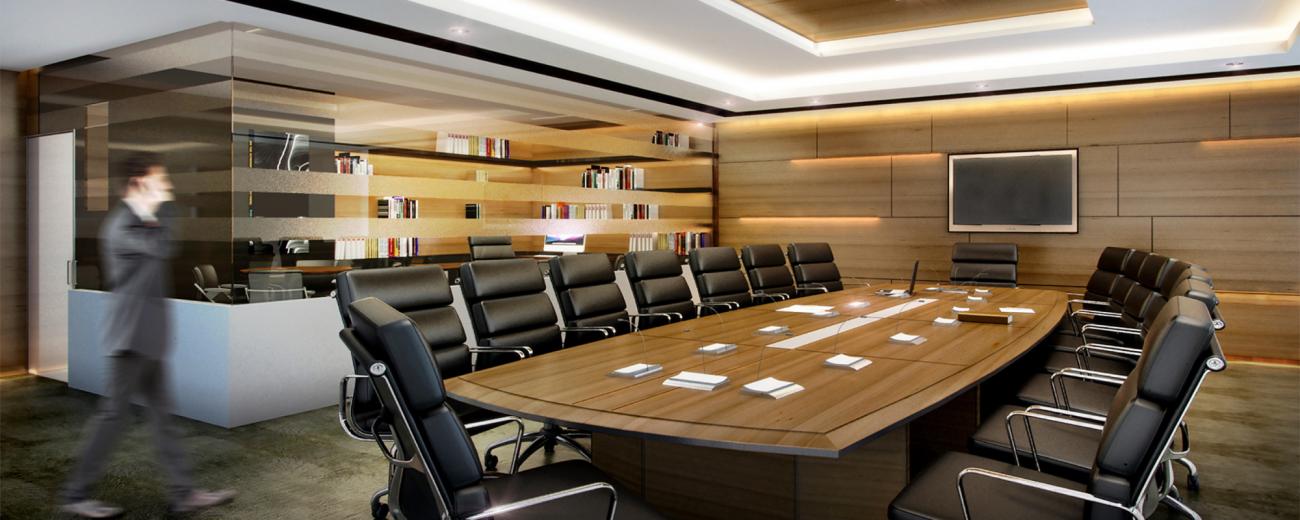Even before the Covid-19 pandemic, the way we worked was shifting. Now, it’s been forever changed – and with that comes the need for modern boardroom technology that can serve multiple functions, without compromising on quality.
Even before the Covid-19 pandemic, the way we worked was shifting. Now, it’s been forever changed – and with that comes the need for modern boardroom technology that can serve multiple functions, without compromising on quality.
Sound Quality, Acoustics, and Reverb Reduction

One of the most significant new demands on the modern boardroom is the ability to host meetings via video conferencing. This means that excellent sound quality –both for participants inside the room and for those attending virtually– has become a necessity.
Unfortunately, many boardrooms just weren’t designed with this functionality in mind. This makes a sound quality overhaul one of the most imperative upgrades for the modern boardroom.
Reverb issues are common, and degrade the sound quality and intelligibility of participants. Reverberation is often caused by flat, hard surfaces (like tables and windows) which bounce soundwaves around the room, causing distortion.
It’s important to note that factors like room size and ceiling height all make a difference in determining the most appropriate upgrades. For example, in a room with an average ceiling height, roughly 40% of the square footage should be treated with sound-dampening solutions for optimal sound quality.
The placement of speakers and microphones should also be reassessed. Array-microphone technologies, which actually steer and direct sound pickup, are ideal.
Wireless Presentation Systems
With so many people working both in the office and from home, the Bring Your Own Device (BYOD) culture has grown exponentially. In a meeting, this means presenters who want to share content from their laptops and tablets on a shared TV, interactive whiteboard or screen would normally have to manually connect their device to it by a cable.
This interrupts the flow of the meeting, disturbs the other participants, and wastes time. In contrast, a wireless presentation system allows attendees to project their laptop, tablet, notebook, or smartphone content without the need to plug in a cable. This makes sharing and collaborating seamless and effortless – and keeps the room free of clutter in the process!
Wireless presentation systems are currently one of the most sought-after modern boardroom technologies. To present their content, the owner of the device can either plug in a small button or ‘puck’ to start sharing or simply connect to the desired screen via the company Wi-Fi.
Pan-Tilt-Zoom (PTZ) Cameras
In face-to-face meetings, it’s natural for participants to look directly at the person speaking. Replicating this experience in a video conference where you have more than one speaker seated at the boardroom table can be a challenge – unless you have a pan-tilt camera!
These can be mounted beneath your main screen and aimed directly at the person who is currently talking, all with the touch of a button on the remote control. They’re designed to work with all the major video conferencing apps and cloud services and don’t require any OS-specific drivers.
This makes it simple to replicate the in-person meeting experience, even if your clients are conferencing in from hundreds of miles away. The modern boardroom technology behind PTZ cameras is similar to that of integrated security PT cameras, which allow you to view different angles of a room with the same camera.
Crestron Flex – Unified Conferencing
From small huddle spaces to large conference venues, Crestron Flex offers a dynamic range of desktop phones, tabletop devices, soundbars, and mobile carts that make collaboration easy.
Built upon the XiO Cloud platform, you can connect, provision, and manage anywhere from 5 to 5,000 devices, regardless of the operating system. The system was designed in partnership with Microsoft, so integrates effortlessly with Microsoft Teams, Zoom Rooms, and BYOD applications.
Each connected device instantly transforms into a multipurpose dashboard, allowing users to control everything from room scheduling and presentation launch to adjusting lighting, shades, and climate.
Crestron Flex solutions include:
- The P-Series Crestron Flex Phone and M-Series Mini Tabletop with Microsoft Teams software – up to 3 people
- The B-Series Smart Soundbar – up to 5 people
- The M-Series Tabletop – up to 15 people
- The M Series with Mic Kit – up to 30 people
- The C-Series customer solutions for large venues and lecture halls – any number of people
- The R-Series Mobile UC mobile solutions – any number of people
Available features include:
- High fidelity audio and high-resolution video
- 360° quad microphone arrays
- Beamforming technology and mic pods
- High-precision, HD intelligent cameras with 150° field of vision
Biamp Conference Room Solutions
Biamp conference room solutions use patented technologies engineered to optimize productivity in rooms of all shapes and sizes.
One of their most innovative offerings is beam tracking intelligent microphones. These point dynamic beams exactly where they are needed as the presenter moves around the space, delivering exceptional intelligibility. Other notable features include single cable solutions, burst power mode to manage peak audio in large meetings with multiple speakers, and acoustic echo cancellation.
- For huddle rooms, Biamp offers the Devio system, complete with an effortless Auto Setup feature
- For medium conference rooms, the Tesira system includes speaker-tracking parlé microphones
- For large conference rooms, the TesiraFORTE easily scales up to handle acoustic challenges with ease
Biamp conference room solutions easily integrate with Microsoft Teams, Google Meet, Zoom, and Cisco WebEx – and are compatible with products from leading suppliers including HP, Lenovo, Logitech, and Poly.
In Conclusion
These 5 modern boardroom technology upgrades should be top of your list if you want to deliver outstanding presentations to your clients and enhance collaboration for your employees.
Contact us to upgrade your boardroom technology or for more information.


